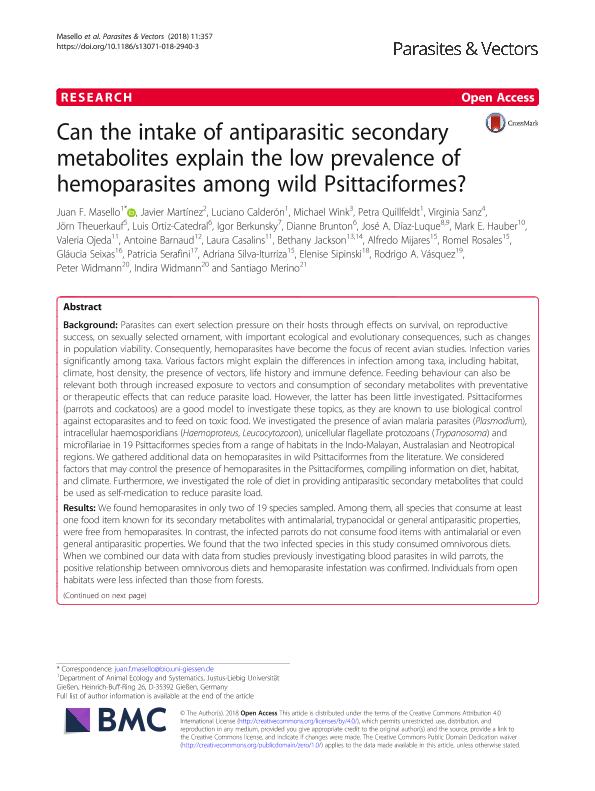Artículo
Can the intake of antiparasitic secondary metabolites explain the low prevalence of hemoparasites among wild Psittaciformes?
Masello, Juan Francisco; Martínez, Javier; Calderón, Pablo Luciano Sebastian ; Wink, Michael; Quillfeldt, Petra; Sanz, Virginia; Theuerkauf, Jörn; Ortiz Catedral, Luis; Berkunsky, Igor
; Wink, Michael; Quillfeldt, Petra; Sanz, Virginia; Theuerkauf, Jörn; Ortiz Catedral, Luis; Berkunsky, Igor ; Brunton, Dianne; Díaz Luque, José A.; Hauber, Mark E.; Ojeda, Valeria Susana
; Brunton, Dianne; Díaz Luque, José A.; Hauber, Mark E.; Ojeda, Valeria Susana ; Barnaud, Antoine; Casalins, Laura
; Barnaud, Antoine; Casalins, Laura ; Jackson, Bethany; Mijares, Alfredo; Rosales, Romel; Seixas, Gláucia; Serafini, Patricia; Silva Iturriza, Adriana; Sipinski, Elenise; Vásquez, Rodrigo A.; Widmann, Peter; Widmann, Indira; Merino, Santiago
; Jackson, Bethany; Mijares, Alfredo; Rosales, Romel; Seixas, Gláucia; Serafini, Patricia; Silva Iturriza, Adriana; Sipinski, Elenise; Vásquez, Rodrigo A.; Widmann, Peter; Widmann, Indira; Merino, Santiago
 ; Wink, Michael; Quillfeldt, Petra; Sanz, Virginia; Theuerkauf, Jörn; Ortiz Catedral, Luis; Berkunsky, Igor
; Wink, Michael; Quillfeldt, Petra; Sanz, Virginia; Theuerkauf, Jörn; Ortiz Catedral, Luis; Berkunsky, Igor ; Brunton, Dianne; Díaz Luque, José A.; Hauber, Mark E.; Ojeda, Valeria Susana
; Brunton, Dianne; Díaz Luque, José A.; Hauber, Mark E.; Ojeda, Valeria Susana ; Barnaud, Antoine; Casalins, Laura
; Barnaud, Antoine; Casalins, Laura ; Jackson, Bethany; Mijares, Alfredo; Rosales, Romel; Seixas, Gláucia; Serafini, Patricia; Silva Iturriza, Adriana; Sipinski, Elenise; Vásquez, Rodrigo A.; Widmann, Peter; Widmann, Indira; Merino, Santiago
; Jackson, Bethany; Mijares, Alfredo; Rosales, Romel; Seixas, Gláucia; Serafini, Patricia; Silva Iturriza, Adriana; Sipinski, Elenise; Vásquez, Rodrigo A.; Widmann, Peter; Widmann, Indira; Merino, Santiago
Fecha de publicación:
19/06/2018
Editorial:
BioMed Central
Revista:
Parasites and Vectors
ISSN:
1756-3305
Idioma:
Inglés
Tipo de recurso:
Artículo publicado
Clasificación temática:
Resumen
Background: Parasites can exert selection pressure on their hosts through effects on survival, on reproductive success, on sexually selected ornament, with important ecological and evolutionary consequences, such as changes in population viability. Consequently, hemoparasites have become the focus of recent avian studies. Infection varies significantly among taxa. Various factors might explain the differences in infection among taxa, including habitat, climate, host density, the presence of vectors, life history and immune defence. Feeding behaviour can also be relevant both through increased exposure to vectors and consumption of secondary metabolites with preventative or therapeutic effects that can reduce parasite load. However, the latter has been little investigated. Psittaciformes (parrots and cockatoos) are a good model to investigate these topics, as they are known to use biological control against ectoparasites and to feed on toxic food. We investigated the presence of avian malaria parasites (Plasmodium), intracellular haemosporidians (Haemoproteus, Leucocytozoon), unicellular flagellate protozoans (Trypanosoma) and microfilariae in 19 Psittaciformes species from a range of habitats in the Indo-Malayan, Australasian and Neotropical regions. We gathered additional data on hemoparasites in wild Psittaciformes from the literature. We considered factors that may control the presence of hemoparasites in the Psittaciformes, compiling information on diet, habitat, and climate. Furthermore, we investigated the role of diet in providing antiparasitic secondary metabolites that could be used as self-medication to reduce parasite load. Results: We found hemoparasites in only two of 19 species sampled. Among them, all species that consume at least one food item known for its secondary metabolites with antimalarial, trypanocidal or general antiparasitic properties, were free from hemoparasites. In contrast, the infected parrots do not consume food items with antimalarial or even general antiparasitic properties. We found that the two infected species in this study consumed omnivorous diets. When we combined our data with data from studies previously investigating blood parasites in wild parrots, the positive relationship between omnivorous diets and hemoparasite infestation was confirmed. Individuals from open habitats were less infected than those from forests. Conclusions: The consumption of food items known for their secondary metabolites with antimalarial, trypanocidal or general antiparasitic properties, as well as the higher proportion of infected species among omnivorous parrots, could explain the low prevalence of hemoparasites reported in many vertebrates.
Archivos asociados
Licencia
Identificadores
Colecciones
Articulos(CCT - TANDIL)
Articulos de CTRO CIENTIFICO TECNOLOGICO CONICET - TANDIL
Articulos de CTRO CIENTIFICO TECNOLOGICO CONICET - TANDIL
Articulos(IBAM)
Articulos de INST.DE BIOLOGIA AGRICOLA DE MENDOZA
Articulos de INST.DE BIOLOGIA AGRICOLA DE MENDOZA
Articulos(INIBIOMA)
Articulos de INST. DE INVEST.EN BIODIVERSIDAD Y MEDIOAMBIENTE
Articulos de INST. DE INVEST.EN BIODIVERSIDAD Y MEDIOAMBIENTE
Citación
Masello, Juan Francisco; Martínez, Javier; Calderón, Pablo Luciano Sebastian; Wink, Michael; Quillfeldt, Petra; et al.; Can the intake of antiparasitic secondary metabolites explain the low prevalence of hemoparasites among wild Psittaciformes?; BioMed Central; Parasites and Vectors; 11; 1; 19-6-2018; 1-15
Compartir
Altmétricas



